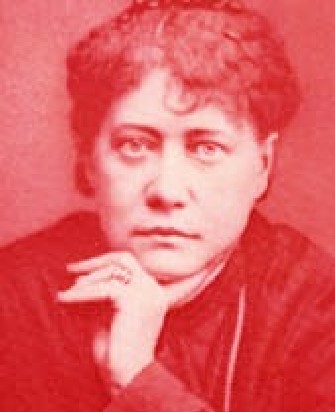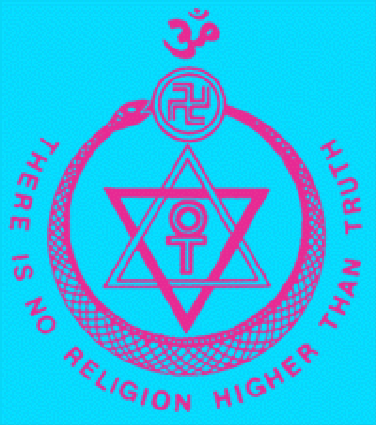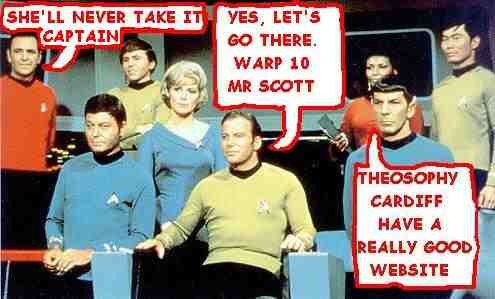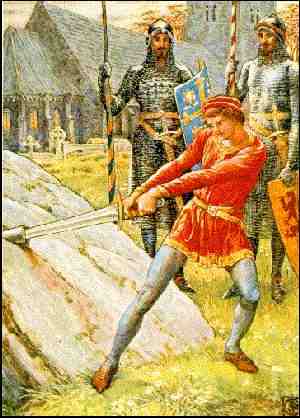Writings
of H P Blavatsky
Cardiff Theosophical Society in Wales
206 Newport Road, Cardiff, Wales, UK. CF24 -1DL

Helena Petrovna Blavatsky (1831 – 1891)
The Founder of Modern Theosophy
Do The Rishis Exist?
By
H
P Blavatsky
FOLLOWING the example of the Parsi Gentleman whose letter you
published in the Theosophist of January, 1882, I am induced to enquire if there
are Hindu Mahatmas among the Himalayan BROTHERS. By the term Hindu, I mean a
believer in Vedas and the Gods they describe. If there are none, will any
Brother of the 1st Section1 be so kind as to enlighten the Hindu Community in
general and the Hindu Theosophists in particular whether any Hindu Rishis of
old still exist in flesh and blood? The adept Himalayan BROTHERS having
explored the unseen universe must necessarily know the Rishis if they exist
now. Tradition says that particularly the following seven are immortal, at
least for the present kalpa.
Ashwathama, Bali, Vyasa, Hanuman, Vibhisana, Kripa, Parasurama.
A HINDU THEOSOPHIST
Editor's Note:--In reply to the first question we are happy to
inform our correspondent that there are Mahatmas among the Himalayan Brothers
who are Hindus--i.e., born of Hindu and Brahmin parents and who recognize the
esoteric meaning of the Vedas and the Upanishads. They agree with Krishna,
Buddha, Vyasa, Suka, Goudapatha and Sankaracharya in considering that the Karma
kanda of the Vedas is of no importance whatsoever so far as man's spiritual
progress is concerned. Our questioner will do well to remember in this
connection Krishna's celebrated advice to Arjuna. "The subject matter of
the Vedas is related to the three Gunas; oh Arjuna, divest thyself of these gunas."
Sankaracharya's uncompromising attitude towards Purwamimansa is too well known
to require any special mention here.
Although the Himalayan Brothers admit the esoteric meaning of the
Vedas and the Upanishads, they refuse to recognize as Gods, the powers and
other spiritual entities mentioned in the Vedas. The language used in the Vedas
is allegorical and this fact has been fully recognized by some of the greatest
Indian Philosophers. Our correspondent will have to prove that the Vedas really
"describe Gods" as they exist, before he can fairly ask us to declare
whether our Masters believe in such gods. We very much doubt if our
correspondent is really prepared to contend seriously, that Agni has four
horns, three legs, two heads, five hands and seven tongues as he is stated to
possess in the Vedas; or that Indra committed adultery with Goutama's wife. We
beg to refer our learned correspondent to Kulluka Bhatta's explanation of the
latter myth (and it is a mere myth in his opinion) and Patanjali's remarks on
the profound esoteric significance of the four horns of Agni, in support of our
assertion that the Vedas do not in reality describe any gods as our questioner
has supposed.
In reply to the second question we are not prepared to say that
"any Hindu Rishis of old still exist in flesh and blood" although we
have our own reasons to believe that some of the great Hindu Adepts of ancient
times have been and are reincarnating themselves occasionally in Tibet and
Tartary; nor is it at all easy for us to understand how it can ever reasonably
be expected that our Himalayan Brothers should discover Hindu Rishis "in
flesh and blood" in their explorations in the "Unseen Universe,"
since "astral" bodies are not usually made up of those earthly
materials.
The tradition alluded to by our correspondent is not literally
true; then, what connection is there between the seven personages named and the
Hindu Rishis? Though we are not called upon to give an explanation of the
tradition in question from our own standpoint, we shall give a few hints which
may enable our readers to ascertain its real significance from what is
contained in Ramayana and Maha Charata.
Asvathama has gained an immortality of infamy.
Parasurama's cruelty made him immortal but he is not supposed to live
in flesh and blood now; he is generally stated to have some sort of existence
in fire though not necessarily in what a Christian would call "hell."
Bali is not an individual properly speaking. The principle de noted
by the name will be known when the esoteric meaning of Thrivikrama Avatar is
better comprehended.
Vyasa is immortal in his incarnations. Let our respected Brother
count how many Vyasas there have been from first to last.
Hanuman was neither a human being nor a monkey: it is one of the powers
of the 7th principle of man (Rama).
Vibhisana. Not a Rakshasa really but the personification of
Satwaguna which is immortal.
Kripa's association with Aswathama will explain the nature of his
immortality.
Theosophist, March, 1883
1 No chela need answer this. except the editor. A.H.T.
______________________

Cardiff
Theosophical Society in
Theosophy
House
206
Newport Road, Cardiff, Wales, UK. CF24 -1DL
Find out
more about
Theosophy
with these links

The Cardiff Theosophical Society Website
The National Wales Theosophy Website
If you
run a Theosophy Group, please feel free
to use
any of the material on this site
The Most Basic Theosophy
Website in the Universe
A quick overview of Theosophy
and the Theosophical Society
If you run a Theosophy Group you
can use this as an introductory handout.
Theosophy Cardiff’s Instant Guide
One liners and quick explanations
H P Blavatsky is
usually the only
Theosophist that
most people have ever
heard of. Let’s put
that right
The Voice of the Silence Website
An Independent Theosophical Republic
Links to Free Online Theosophy
Study Resources; Courses,
Writings,
The main criteria
for the inclusion of
links on this
site is that they have some
relationship
(however tenuous) to Theosophy
and are
lightweight, amusing or entertaining.
Topics include
Quantum Theory and Socks,
Dick Dastardly and Legendary Blues Singers.
A selection of
articles on Reincarnation
Provided in
response to the large
number of
enquiries we receive at
Cardiff
Theosophical Society on this subject
The Voice of the Silence Website
This is for everyone, you don’t have to live
in Wales to make good use of this Website
No
Aardvarks were harmed in the
The Spiritual Home of Urban Theosophy
The Earth Base for Evolutionary Theosophy
A B C D EFG H IJ KL M N OP QR S T UV WXYZ
Complete Theosophical Glossary in Plain Text Format
1.22MB
________________
Preface
Theosophy and the Masters General Principles
The Earth Chain Body and Astral Body Kama – Desire
Manas Of Reincarnation Reincarnation Continued
Karma Kama Loka
Devachan
Cycles
Arguments Supporting Reincarnation
Differentiation Of Species Missing Links
Psychic Laws, Forces, and Phenomena
Psychic Phenomena and Spiritualism
Quick Explanations with
Links to More Detailed Info
What is Theosophy ? Theosophy Defined (More Detail)
Three Fundamental Propositions Key Concepts of Theosophy
Cosmogenesis Anthropogenesis Root Races
Ascended Masters After Death States
The Seven Principles of Man Karma
Reincarnation Helena Petrovna Blavatsky
Colonel Henry Steel Olcott William Quan Judge
The Start of the Theosophical
Society
History of the Theosophical
Society
Theosophical Society Presidents
History of the Theosophical
Society in Wales
The Three Objectives of the
Theosophical Society
Explanation of the Theosophical
Society Emblem
The Theosophical Order of
Service (TOS)
Glossaries of Theosophical Terms
Index of
Searchable
Full Text
Versions of
Definitive
Theosophical
Works
H P Blavatsky’s Secret Doctrine
Isis Unveiled by H P Blavatsky
H P Blavatsky’s Esoteric Glossary
Mahatma Letters to A P Sinnett 1 - 25
A Modern Revival of Ancient Wisdom
(Selection of Articles by H P Blavatsky)
The Secret Doctrine – Volume 3
A compilation of H P Blavatsky’s
writings published after her death
Esoteric Christianity or the Lesser Mysteries
The Early Teachings of The Masters
A Collection of Fugitive Fragments
Fundamentals of the Esoteric Philosophy
Mystical,
Philosophical, Theosophical, Historical
and Scientific
Essays Selected from "The Theosophist"
Edited by George Robert Stow Mead
From Talks on the Path of Occultism - Vol. II
In the Twilight”
Series of Articles
The In the
Twilight” series appeared during
1898 in The
Theosophical Review and
from 1909-1913
in The Theosophist.
compiled from
information supplied by
her relatives
and friends and edited by A P Sinnett
Letters and
Talks on Theosophy and the Theosophical Life
Obras
Teosoficas En Espanol
Theosophische
Schriften Auf Deutsch
An Outstanding
Introduction to Theosophy
By a student of
Katherine Tingley
Elementary Theosophy Who is the Man? Body and Soul
Body, Soul and Spirit Reincarnation Karma
Guide to the
Theosophy
Wales King Arthur Pages
Arthur draws
the Sword from the Stone
The Knights of The Round Table
The Roman Amphitheatre at Caerleon,
Eamont Bridge, Nr Penrith, Cumbria, England.
Geoffrey of Monmouth
(History of the Kings of Britain)
The reliabilty of this work has long been a subject of
debate but it is the first definitive account of Arthur’s
Reign
and one which puts Arthur in a historcal context.
and his version’s political agenda
According to Geoffrey of Monmouth
The first written mention of Arthur as a heroic figure
The British leader who fought twelve battles
King Arthur’s ninth victory at
The Battle of the City of the Legion
King Arthur ambushes an advancing Saxon
army then defeats them at Liddington Castle,
Badbury, Near Swindon, Wiltshire, England.
King Arthur’s twelfth and last victory against the Saxons
Traditionally Arthur’s last battle in which he was
mortally wounded although his side went on to win
No contemporary writings or accounts of his life
but he is placed 50 to 100 years after the accepted
King Arthur period. He refers to Arthur in his inspiring
poems but the earliest written record of these dates
from over three hundred years after Taliesin’s death.
Pendragon Castle
Mallerstang Valley, Nr Kirkby Stephen,
A 12th Century Norman ruin on the site of what is
reputed to have been a stronghold of Uther Pendragon
From wise child with no
earthly father to
Megastar of Arthurian
Legend
History of the Kings of Britain
Drawn from the Stone or received from the Lady of the Lake.
Sir Thomas Malory’s Le Morte d’Arthur has both versions
with both swords called Excalibur. Other versions
5th & 6th Century Timeline of Britain
From the departure of the Romans from
Britain to the establishment of sizeable
Anglo-Saxon Kingdoms
Glossary of
Arthur’s uncle:- The puppet ruler of the Britons
controlled and eventually killed by Vortigern
Amesbury, Wiltshire, England. Circa 450CE
An alleged massacre of Celtic Nobility by the Saxons
History of the Kings of Britain
Athrwys / Arthrwys
King of Ergyng
Circa 618 - 655 CE
Latin: Artorius; English: Arthur
A warrior King born in Gwent and associated with
Caerleon, a possible Camelot. Although over 100 years
later that the accepted Arthur period, the exploits of
Athrwys may have contributed to the King Arthur Legend.
He became King of Ergyng, a kingdom between
Gwent and Brycheiniog (Brecon)
Angles under Ida seized the Celtic Kingdom of
Bernaccia in North East England in 547 CE forcing
Although much later than the accepted King Arthur
period, the events of Morgan Bulc’s 50 year campaign
to regain his kingdom may have contributed to
Old Welsh: Guorthigirn;
Anglo-Saxon: Wyrtgeorn;
Breton: Gurthiern; Modern Welsh; Gwrtheyrn;
*********************************
An earlier ruler than King Arthur and not a heroic figure.
He is credited with policies that weakened Celtic Britain
to a point from which it never recovered.
Although there are no contemporary accounts of
his rule, there is more written evidence for his
existence than of King Arthur.
How Sir Lancelot slew two giants,
From Sir Thomas Malory’s Le Morte d’Arthur
How Sir Lancelot rode disguised
in Sir Kay's harness, and how he
From Sir Thomas Malory’s Le Morte d’Arthur
How Sir Lancelot jousted against
four knights of the Round Table,
From Sir Thomas Malory’s Le Morte d’Arthur
Try
these if you are looking for a local
Theosophy
Group or Centre
UK Listing of Theosophical Groups
Cardiff
Theosophical Society in Wales
206 Newport Road, Cardiff, Wales, UK. CF24 -1DL
